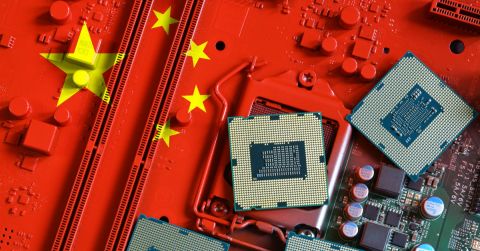RGB LED Drivers Illuminate Millions of Colors

RGB LEDs are light-emitting diodes (LEDs) that incorporate three LEDs into one package. Each of the three LEDs within the package is a different color: red, green, or blue (RGB). Each color has a dedicated anode pin and all colors share one cathode pin to ground. The IC driver is used to mix colors within each RGB to create dynamically changing colors for lighting.
Each color diode of the RGB LED may be driven by a current-controlled source within the driver IC. Luminosity of each LED may be varied by changing the current flowing through each color diode through pulse-width modulation (PWM). By varying each LED within the RGB simultaneously, many thousands of color tints are available to use in your application.
Applications for use of RGB LEDs are numerous and include the range from small portable devices to industrial lighting systems, from fun lights within consumer electronics to art installations within public spaces. RGB LEDs and their driver ICs are energy efficient allowing use of one power source across digital design blocks. Low power budgets make them ideal in small hand-held devices.
 RGB LED drivers illuminate keyboards, displays, and fun lights
RGB LED drivers illuminate keyboards, displays, and fun lights
Defining Characteristics When Selecting an RGB LED Driver
RGB LEDs are integrated diodes containing three colors along with dedicated pins to autonomously drive each color. The tint of each may be modified by changing its bias current. Changing its bias current is done using pulse-width modulation. Each LED within the RGB may be pulse-width modulated simultaneously using an RGB LED driver IC. By PWMing each LED in differing patterns millions of color tints may be produced and used for color control in illumination applications. Some of the terms commonly used when using RGB LEDs and their drivers are:
Apparent Brightness: The luminosity of a color (as relates to this article) diminished by distance from the color.
Charge Pump: A kind of DC to DC converter that uses capacitors for energetic charge storage to raise or lower voltage.
Diode: A semiconductor device with two terminals, typically allowing the flow of current in one direction only.
Haptic: Relating to the sense of touch, in particular relating to the perception and manipulation of objects using the senses of touch and proprioception.
IC: Integrated circuit is an electronic circuit formed on a small piece of semiconductor material, performing the same function as a larger circuit made from discrete components.
LCD: Liquid crystal display screens have replaced heavy, bulky cathode ray tube displays and are available in a wide range of screen sizes for use in consumer and industrial display applications.
LED: Light-emitting diode is a two-lead semiconductor light source.
Luminosity: The intrinsic brightness, as distinct from apparent brightness, of a color (within the context of this article).
MCU: Master Control Unit within a mixed signal electronic system is the microprocessor and associated control circuits that drive the system.
Proprioception: The sense of the relative position of one’s own parts of the body and strength of effort being employed in movement.
PWM: Pulse-width modulation is a technique used to encode a message into a pulsing signal.
RGB: Red-Green-Blue color model is an additive color model in which red, green and blue light are added together in various ways to reproduce a broad array of colors.
RGB LEDs are used for very simple color illuminations and for very complex color illuminations. IC drivers are plentiful and simple or complex drivers can be sourced dependent on your need.
Parts For Consideration When Selecting an RGB LED Driver
We look at three possible parts for selection when driving your RGB LEDs. All incorporate an internal charge pump to provide forward voltage for the green and blue LEDs within the RGB. The first is the simplest having one-pin digital control for color mixing of one RGB LED. The next has programmable current sources along with PWM functionality driven from an external microprocessor for one RGB LED. The third is capable of driving itself or using a microprocessor to drive both its programmable current sources and its PWM for three RGB LEDs.
 RGB LED drivers illuminate with color mixing
RGB LED drivers illuminate with color mixing
Each of the parts we highlight is available for sourcing and costing on our website, along with specification summaries and links to datasheets and other technical documentation.
Linear Technology, LTC3212 RGB LED Driver and Charge Pump
This is an RGB LED integrated circuit that drives one RGB LED or three individual, one-color LEDs. It contains an internal charge pump to provide forward voltages above the IC’s source rail which is no larger than 5.5V. Each driver may be biased to provide up to 25mA of forward current. This IC comes in a 12-lead DFN package.
The LTC®3212 is a low noise charge pump RGB LED driver capable of driving three LEDs up to 25mA each from a 2.7V to 5.5V input. Low external part count (one flying capacitor, two bypass capacitors and one to three programming resistors) makes the LTC3212 ideally suited for small, battery-powered applications.
Each LED may be individually turned on or off via single pin interface. The current through the LEDs may be individually programmed with resistors or may share a single programming resistor. White mode adjusts the red, green and blue LED current ratios for a white light when all three LEDs are programmed to be on.
 This is found on page 1 in LTC3212 RGB LED Driver and Charge Pump datasheet
This is found on page 1 in LTC3212 RGB LED Driver and Charge Pump datasheet
This IC is for straight-forward lighting requirements using one-pin control to vary the lights. It is suitable for cellular phones, for media players, and for RGB backlights.
On-Semiconductor, NCP5623C LED Driver, I2C Controlled RGB, Triple Output
This is an RGB Driver able to actuate one RGB LED or three white LEDs. It comes in a very compact LLGA-12 package making it suitable for use in small portable devices. It is designed to be used together with an MCU using I2C protocol for data transfer. It contains a charge pump to provide necessary forward voltages for both the green and blue LED within the RGB. There is a load current calculation performed to select reference bias resistor for each LED within the RGB. For color mixing via luminosity adjustment a set of dedicated PWMs are available. Each PWM has 32 steps providing programming of 32,768 color hues.
The NCP5623C mixed analog circuit is a triple output LED driver dedicated to the RGB illumination or backlight LCD display. The built-in DC/DC converter is based on a high-efficient charge pump structure with operating mode 1x and 2x. It provides a 94% peak efficiency. The tiny package makes the device suitable for room limited portable applications.
 This is taken from page 11 in NCP5623C Triple Output I2C Controlled RGB LED Driver datasheet
This is taken from page 11 in NCP5623C Triple Output I2C Controlled RGB LED Driver datasheet
This part is ideally suited for small portable applications to provide display backlighting. It may provide multicolor illuminations, produce digital cellular phone camera photo flash, or drive LCD display simultaneously with keyboard illumination.
Texas Instruments LP55231 Nine-Channel RGB, White-LED Driver With Internal Program Memory and Integrated Charge Pump
This is an RGB Driver able to activate either three RGB LEDs or nine white LEDs. It comes in a WQFN quad flat no-leads package. This part has internal program memory allowing operation with, or without, a microprocessor. It uses I2C protocol to communicate and the controller may read from or write to its internal registers. The part includes a charge pump to generate forward voltages for the green and blue LEDs within the RGB LED. Forward driving current is set using control registers in 100µA steps up to 25.5mA. LED luminance is controlled by PWM via dedicated registers with internal resolution of 12 bits.
The LP55231 is a 9-channel LED driver designed to produce lighting effects for mobile devices. A high-efficiency charge pump enables LED driving over full Li-Ion battery voltage range. The device is equipped with an internal program memory, which allows operation without processor control.
The LP55231 has an I2C-compatible control interface with four pin-selectable addresses. The INT pin can be used to notify the processor when a lighting sequence has ended (interrupt function). Also, the device has a trigger input interface, which allows synchronization, for example, between multiple LP55231 devices. Excellent efficiency is maintained over a wide operating range by autonomously selecting the best charge pump gain based on LED forward voltage requirements. The device is able to automatically enter power-save mode when LED outputs are not active, thus lowering idle current consumption down to 10µA (typical). Only four small and low-cost ceramic capacitors are required.
 Using two LP55231 in the same application
This is found on page 46 in LP55231 Nine-Channel RGB, White-LED Driver With Internal Program Memory and Integrated Charge Pump datasheet
Using two LP55231 in the same application
This is found on page 46 in LP55231 Nine-Channel RGB, White-LED Driver With Internal Program Memory and Integrated Charge Pump datasheet
This part is well suited to drive at least three RGB LEDs or it may be strung together to drive multiple RGBs. It may also be used to drive white LEDs or be used for other applications such as haptic control or H-bridge motor drive. It can be set up to independently drive each output or to drive banks of outputs. The banks may be synced to drive keypad illumination, funlights, or indicator lights. It may also be used as a programmable current source for use in fire notification, electronic thermostats, electronic locks, robotics, intruder notification, light switches and dimmer, and gaming and smart headphones.
RGB LEDs may be driven with ICs designed to set and refine the color mix over a wide spectrum. This is primarily done digitally using internal registers and I2C communication buses. Each vendor driver IC has developed techniques for both setting the driver current and for mixing color via PWM control. The ICs are typically driven from 2.2V to 5.5V and integrate a charge pump to provide forward voltages for both the green and blue LEDs within the RGB.
Stay up-to-date with our latest articles by signing up for our newsletter.









 Back
Back